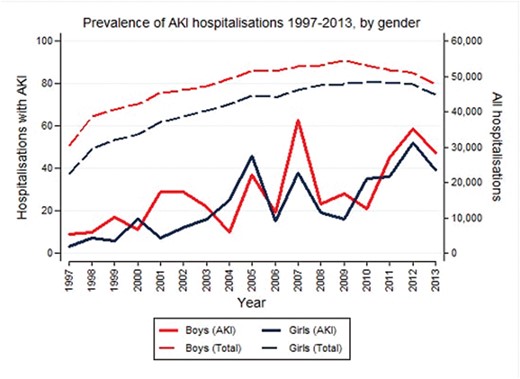-
PDF
- Split View
-
Views
-
Cite
Cite
Alasdair Henderson, Masao Iwagami, Christian Bottomley, Kathryn Mansfield, Laurie Tomlinson, Dorothea Nitsch, MO041
INCIDENCE AND RISK FACTORS FOR PAEDIATRIC ACUTE KIDNEY INJURY IN THE UK, Nephrology Dialysis Transplantation, Volume 32, Issue suppl_3, May 2017, Page iii60, https://doi.org/10.1093/ndt/gfx121Close - Share Icon Share
INTRODUCTION AND AIMS: Acute Kidney Injury (AKI) is a condition that affects a large number of adults in the UK, carrying a large disease burden. Research into AKI in children is limited.This study aimed to explore changes in the proportion of paediatric hospitalisations with AKI since 1997, investigate common characteristics of AKI hospitalisations compared to all hospitalisations, and identify potential risk factors of AKI.
METHODS: We used data from the Clinical Practice Research Datalink (CPRD) which was linked to the Hospital Episode Statistics database (HES). HES data were only available for practices participating in CRPD who had agreed for HES linkage. We defined a diagnosis of AKI/acute renal failure using ICD 10 N17 code in HES. Additional information on previous diagnoses and medication was derived from CPRD.We explored trends in AKI diagnosis through the proportion of all paediatric hospitalisations that include an AKI diagnosis. We also explored common characteristics in AKI diagnoses relative to other hospitalisations. Finally, we designed a matched case-control study and analysed using conditional logistic regression to assess the effect of key risk factors on the odds of AKI diagnosis, using risk factor information from linked CPRD records.

MO041 Figure
CONCLUSIONS: The number of children with AKI diagnosed in the UK remains low in comparison to research in children in other countries and in adults, suggesting that AKI is underreported in the UK. Specific existing diagnoses (e.g. sepsis, leukaemia) during hospital admissions, congenital disorders and surgery put children at higher risk of AKI.





Comments